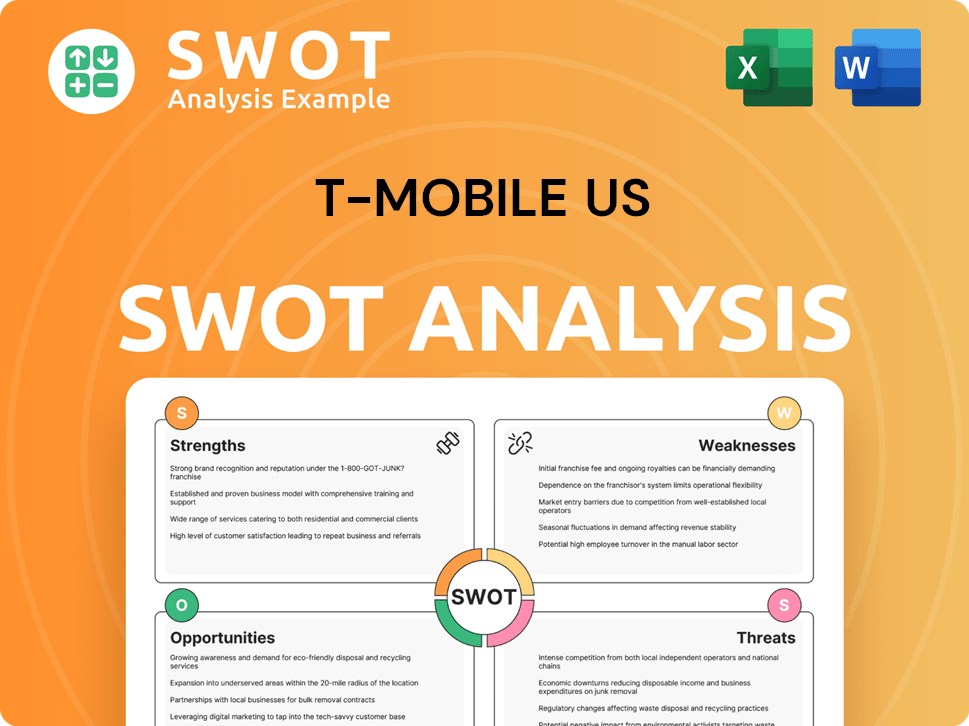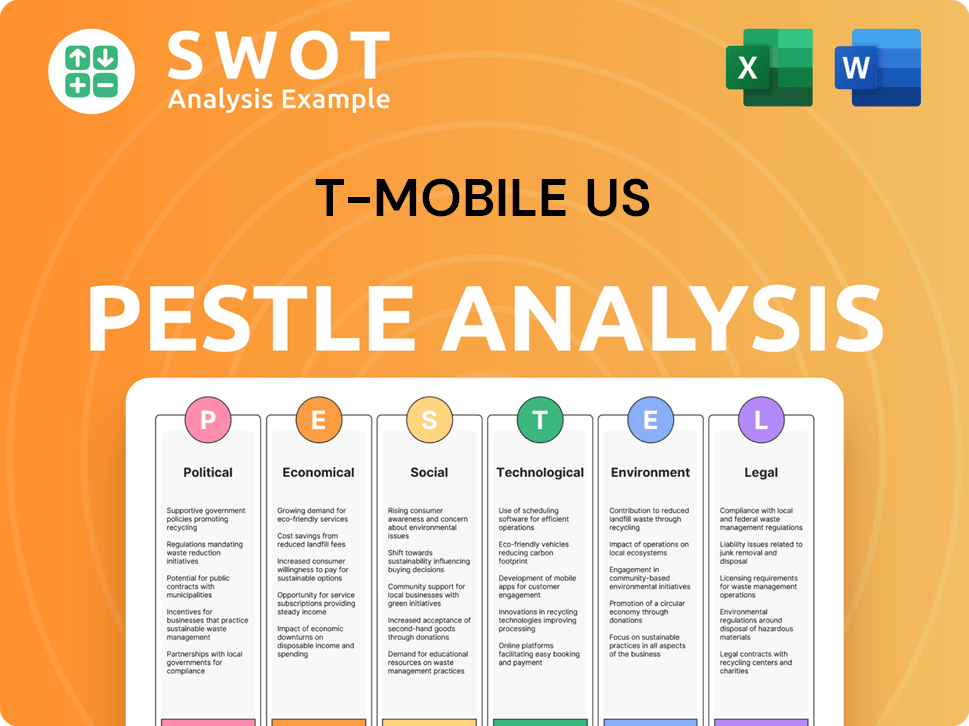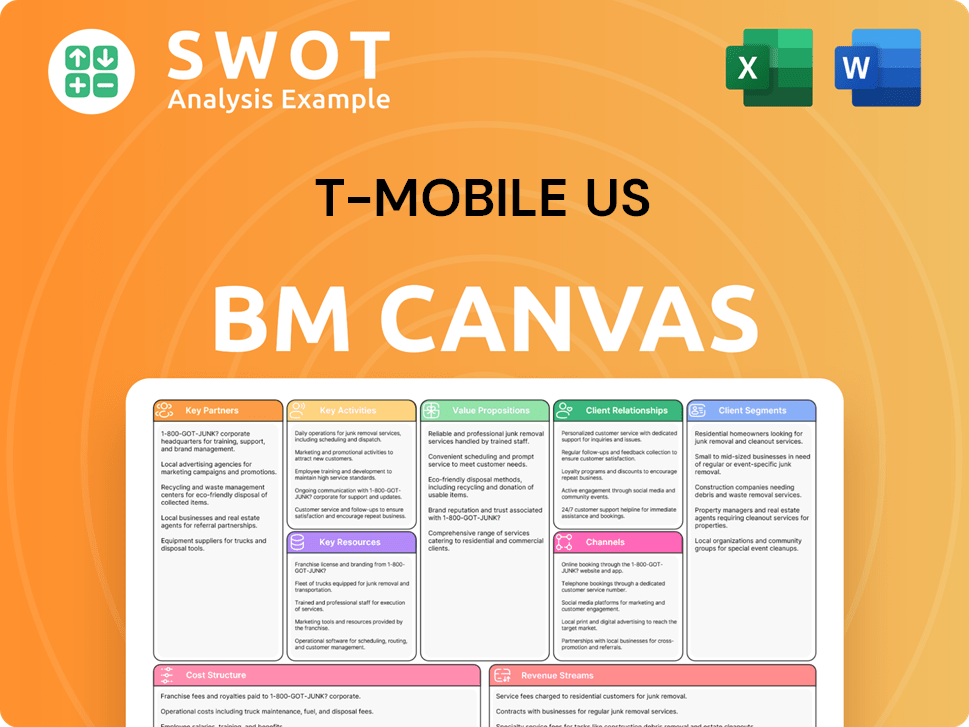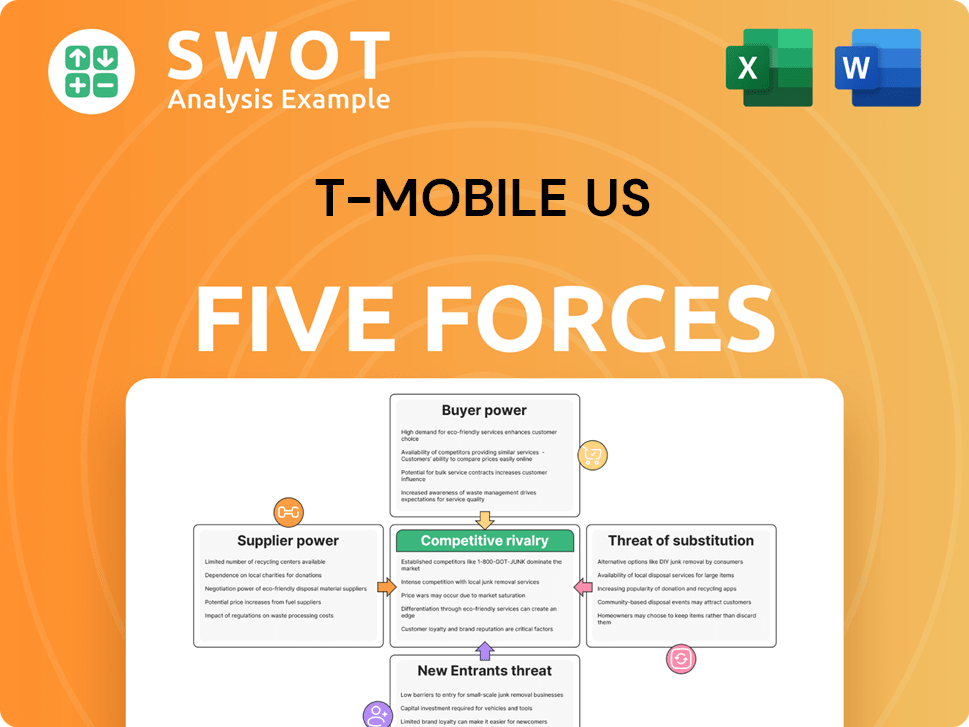T-Mobile US Bundle
How Does T-Mobile US Dominate the Wireless World?
T-Mobile US has dramatically reshaped the American wireless industry, challenging established players with its innovative "Un-carrier" approach. This T-Mobile US SWOT Analysis reveals the strategies behind its impressive subscriber growth and market share gains. With a focus on customer-friendly features and a rapidly expanding 5G network, T-Mobile continues to redefine what consumers expect from their mobile carrier.

This exploration into the T-Mobile company will uncover the secrets behind its operational success, from its diverse revenue streams to its strategic advantages in a competitive landscape. We'll examine how T-Mobile's 5G network availability and its commitment to customer satisfaction have fueled its rise, providing valuable insights for anyone interested in the wireless provider's future. Discover how T-Mobile US is not just surviving, but thriving in the ever-evolving world of cell phone service.
What Are the Key Operations Driving T-Mobile US’s Success?
T-Mobile US, a prominent mobile carrier, creates and delivers value through its robust wireless network and customer-focused strategies. The company offers mobile voice, messaging, and high-speed data services to a diverse customer base, from individual consumers to businesses. These services are powered by its advanced 5G network, which ensures broad coverage and reliable connectivity.
The value proposition of T-Mobile centers on providing simplified, transparent, and customer-friendly wireless experiences. This includes eliminating traditional pain points such as annual service contracts and hidden charges. The company's operational efficiency and innovation translate into customer benefits like faster speeds and greater flexibility, differentiating it from competitors.
T-Mobile's core operations revolve around its wireless network infrastructure and customer-centric approach. This involves continuous investment in network deployment, spectrum acquisition, and technological advancements. The company's supply chain is critical for sourcing and distributing mobile devices and accessories through retail stores, online channels, and authorized dealers. Strategic partnerships, particularly with device manufacturers, are essential for offering the latest smartphones and connected devices. Its distribution networks encompass a vast retail footprint and a strong online presence, supported by extensive customer service operations.
T-Mobile's network is a cornerstone of its operations, with significant investments in 5G technology. As of early 2025, its Extended Range 5G covers over 330 million people, and Ultra Capacity 5G reaches more than 300 million people. This extensive coverage is a key differentiator in the competitive wireless market.
T-Mobile's 'Un-carrier' strategy focuses on simplifying the customer experience. This includes offering transparent pricing, eliminating contracts, and providing innovative services. This approach aims to address common customer frustrations in the wireless industry and build brand loyalty. You can learn more about this in Marketing Strategy of T-Mobile US.
T-Mobile offers a range of services, including mobile voice, messaging, and high-speed data. The company continues to innovate, as seen with its 5G Home Internet service, which had over 5.2 million customers by the end of 2024. This service leverages excess 5G network capacity, providing an alternative to traditional broadband.
T-Mobile's supply chain is crucial for sourcing and distributing mobile devices and accessories. These are sold through retail stores, online channels, and authorized dealers. Strategic partnerships with device manufacturers are essential for offering the latest smartphones and connected devices.
T-Mobile's success is driven by its aggressive network expansion, particularly in 5G, and its commitment to disrupting the traditional wireless business model. The company's focus on customer experience and innovative services sets it apart from competitors.
- Extensive 5G Network Coverage: Reaching over 300 million people with Ultra Capacity 5G.
- Customer-Focused Approach: Eliminating pain points like contracts and hidden fees.
- Innovative Services: Offering services like 5G Home Internet to expand its reach.
- Strategic Partnerships: Collaborating with device manufacturers to offer the latest technology.
T-Mobile US SWOT Analysis
- Complete SWOT Breakdown
- Fully Customizable
- Editable in Excel & Word
- Professional Formatting
- Investor-Ready Format

How Does T-Mobile US Make Money?
The primary revenue streams and monetization strategies of the T-Mobile US company revolve around its wireless services, device sales, and wholesale network access. The majority of its income is derived from postpaid and prepaid service revenues, which include monthly recurring charges for voice, text, and data plans. This focus on recurring revenue streams ensures a stable financial foundation for the mobile carrier.
Device sales, including smartphones and tablets, are another vital revenue source. These sales not only attract new customers but also facilitate upgrades for existing subscribers, often bundled with service plans or financed through installment agreements. The company also capitalizes on its extensive network by providing wholesale wireless network access to mobile virtual network operators (MVNOs), generating additional revenue without the direct operational costs of serving end consumers.
Innovative strategies include tiered pricing for various service plans, offering different data and feature levels to meet diverse customer needs. Bundled services, such as combining wireless plans with home internet or streaming service perks, are also employed to boost customer retention and average revenue per user (ARPU). T-Mobile has consistently focused on increasing its postpaid subscriber base, as these customers typically have higher ARPU and lower churn rates, leading to more predictable revenue.
In the fourth quarter of 2024, T-Mobile reported total service revenues of $16.3 billion. Postpaid service revenues were the largest contributor, reaching $12.8 billion.
The company has expanded into new revenue streams with its 5G Home Internet service, leveraging its 5G network to offer broadband alternatives.
Over time, T-Mobile has consistently focused on increasing its postpaid subscriber base, as these customers generally have higher ARPU and lower churn rates.
Bundled services, such as combining wireless plans with home internet or streaming service perks, are also employed to increase customer stickiness and average revenue per user (ARPU).
The company also monetizes its extensive network infrastructure by providing wholesale wireless network access to mobile virtual network operators (MVNOs).
Innovative monetization strategies include tiered pricing for its various service plans, offering different levels of data and features to cater to diverse customer needs.
The main revenue streams for T-Mobile include wireless services, device sales, and wholesale network access. Understanding how these streams contribute to the company's financial performance is crucial. For more insights, you can review the Competitors Landscape of T-Mobile US.
- Postpaid service revenues are the largest contributor.
- Device sales are important for customer acquisition and upgrades.
- Wholesale network access provides additional revenue.
- Bundled services and tiered pricing enhance ARPU.
T-Mobile US PESTLE Analysis
- Covers All 6 PESTLE Categories
- No Research Needed – Save Hours of Work
- Built by Experts, Trusted by Consultants
- Instant Download, Ready to Use
- 100% Editable, Fully Customizable

Which Strategic Decisions Have Shaped T-Mobile US’s Business Model?
The journey of T-Mobile US has been marked by significant strategic shifts and pivotal moments. A key move was the 'Un-carrier' strategy launched in 2013, which revolutionized the wireless industry by eliminating contracts and introducing customer-friendly features. This approach fueled substantial subscriber growth, setting T-Mobile apart from its competitors. Following this, the merger with Sprint in April 2020 created a stronger entity with a larger customer base and enhanced 5G network capabilities.
Operationally, T-Mobile has consistently prioritized the rapid deployment of its 5G network. Despite challenges like supply chain disruptions and the complexities of integrating Sprint's network, the company has shown resilience. By the end of 2024, its 5G network covered over 330 million people with Extended Range 5G and more than 300 million people with Ultra Capacity 5G, demonstrating its commitment to network leadership. These advancements have been crucial in maintaining and expanding its market share.
The company's competitive edge stems from its strong brand recognition as the 'Un-carrier,' known for customer-friendly policies, its extensive and rapidly expanding 5G network, and the economies of scale achieved through the Sprint merger. T-Mobile's focus on innovative offerings like 5G Home Internet and its aggressive pursuit of market share have allowed it to sustain its business model. The company continues to adapt to new trends by investing in emerging technologies and expanding its service offerings beyond traditional mobile connectivity, aiming to capture new growth opportunities in a dynamic telecommunications landscape. For more details on the target audience, explore the Target Market of T-Mobile US.
The 'Un-carrier' strategy (2013) eliminated contracts and introduced unlimited data plans. The merger with Sprint (April 2020) expanded the customer base and spectrum holdings. These moves significantly impacted the company's market position and financial performance.
Rapid 5G network deployment is a core strategy, with coverage expanding rapidly. Investment in 5G Home Internet and other innovative services diversifies offerings. The company focuses on aggressive market share growth and customer acquisition.
Strong brand recognition as the 'Un-carrier' with customer-friendly policies. Extensive and rapidly expanding 5G network leadership. Economies of scale achieved through the Sprint merger. These factors drive customer loyalty and market competitiveness.
T-Mobile US has shown robust financial performance, driven by subscriber growth and network expansion. The merger with Sprint has led to increased revenue and operational efficiencies. The company continues to invest in its 5G network to maintain its competitive edge.
T-Mobile's 5G network covers over 330 million people with Extended Range 5G and more than 300 million people with Ultra Capacity 5G by the end of 2024. The company has consistently expanded its 5G Home Internet service, aiming to capture a larger share of the home broadband market. T-Mobile's focus on customer-friendly policies and innovative offerings has contributed to strong subscriber growth.
- 5G Network Expansion: Continued investment in 5G infrastructure.
- Customer Growth: Driven by attractive plans and customer-centric policies.
- Service Diversification: Expansion into 5G Home Internet and other services.
- Financial Health: Strong revenue growth and operational efficiencies.
T-Mobile US Business Model Canvas
- Complete 9-Block Business Model Canvas
- Effortlessly Communicate Your Business Strategy
- Investor-Ready BMC Format
- 100% Editable and Customizable
- Clear and Structured Layout

How Is T-Mobile US Positioning Itself for Continued Success?
T-Mobile US holds a strong position in the U.S. wireless industry, consistently competing with AT&T and Verizon. As a leading mobile carrier, T-Mobile continues to grow its subscriber base, demonstrating its market share and customer loyalty. Its focus is primarily on the U.S. and its territories, with a significant presence.
The company's 'Un-carrier' strategy and aggressive 5G network rollout have been key to its success. T-Mobile US reported 1.5 million net account additions in Q4 2024, bringing its total postpaid and prepaid customers to over 122 million, highlighting strong customer loyalty and network expansion efforts.
T-Mobile is a significant wireless provider in the U.S., known for its competitive pricing and innovative services. Its 'Un-carrier' approach has disrupted the market, attracting customers with unique offerings. Its 5G network expansion has improved its coverage and performance, enhancing its market position.
T-Mobile faces risks from regulatory changes, impacting spectrum allocation and competitive practices. Intense competition from AT&T and Verizon, both investing heavily in 5G, remains a challenge. Technological disruption and changing consumer preferences also pose potential risks.
T-Mobile plans to expand its 5G network, focusing on Ultra Capacity 5G to drive growth. The company aims to increase subscribers in both postpaid and prepaid segments and expand its home internet service. Leadership emphasizes innovation and customer satisfaction.
T-Mobile intends to leverage its network to offer differentiated services and explore new business opportunities. The company will continue its 'Un-carrier' approach to attract and retain customers. For more details, review the Brief History of T-Mobile US.
T-Mobile faces challenges such as competition and regulatory changes but has opportunities for growth through 5G expansion and new services. The company's focus on innovation and customer satisfaction will be critical. T-Mobile continues to invest in its network to maintain a competitive edge.
- Intense competition from AT&T and Verizon.
- Regulatory changes impacting spectrum and competition.
- Technological disruption and evolving consumer preferences.
- Opportunities in 5G expansion and home internet.
T-Mobile US Porter's Five Forces Analysis
- Covers All 5 Competitive Forces in Detail
- Structured for Consultants, Students, and Founders
- 100% Editable in Microsoft Word & Excel
- Instant Digital Download – Use Immediately
- Compatible with Mac & PC – Fully Unlocked

Related Blogs
- What are Mission Vision & Core Values of T-Mobile US Company?
- What is Competitive Landscape of T-Mobile US Company?
- What is Growth Strategy and Future Prospects of T-Mobile US Company?
- What is Sales and Marketing Strategy of T-Mobile US Company?
- What is Brief History of T-Mobile US Company?
- Who Owns T-Mobile US Company?
- What is Customer Demographics and Target Market of T-Mobile US Company?
Disclaimer
All information, articles, and product details provided on this website are for general informational and educational purposes only. We do not claim any ownership over, nor do we intend to infringe upon, any trademarks, copyrights, logos, brand names, or other intellectual property mentioned or depicted on this site. Such intellectual property remains the property of its respective owners, and any references here are made solely for identification or informational purposes, without implying any affiliation, endorsement, or partnership.
We make no representations or warranties, express or implied, regarding the accuracy, completeness, or suitability of any content or products presented. Nothing on this website should be construed as legal, tax, investment, financial, medical, or other professional advice. In addition, no part of this site—including articles or product references—constitutes a solicitation, recommendation, endorsement, advertisement, or offer to buy or sell any securities, franchises, or other financial instruments, particularly in jurisdictions where such activity would be unlawful.
All content is of a general nature and may not address the specific circumstances of any individual or entity. It is not a substitute for professional advice or services. Any actions you take based on the information provided here are strictly at your own risk. You accept full responsibility for any decisions or outcomes arising from your use of this website and agree to release us from any liability in connection with your use of, or reliance upon, the content or products found herein.